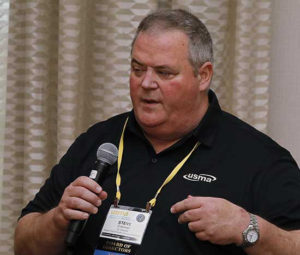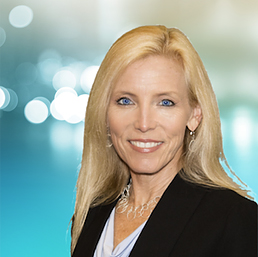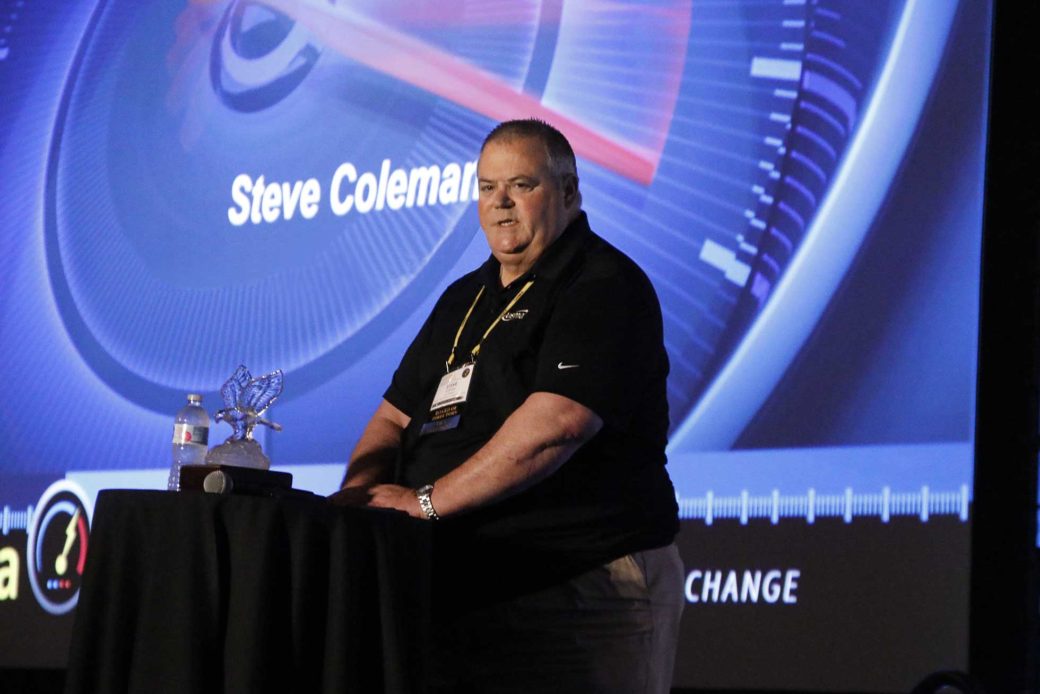In preparation for USMA’s upcoming conference in Scottsdale, Arizona, I had the chance to sit down with Steve Coleman, President of USMA and Senior Director of Sourcing, PG&E who shared his words of wisdom on the utilities industry, trends in sourcing and thoughts on how to get the most out of this and all conferences.
Sarah Holliman (Sarah): How did you choose sourcing as a career? Was it purposeful or by accident?
Steve Coleman (Steve): My journey started in the Materials department, which is part of Supply Chain. Sourcing is part of that group also. I worked my way up to successive leadership positions, and finally became the Director of Materials Operations, before making a sidewise journey into the Sourcing department in 2007. I think it is rare in companies, and especially within PG&E, for a leader to have a complete understanding of all parts of the supply chain – material operations, materials planning, supplier diversity, sourcing, procurement operations, etc. But I wanted that understanding and had the opportunity to learn more, so I took that step.
Sarah: How long have you been at PG&E and how have you seen sourcing change over that time frame?
Steve: I’ve been at PG&E for 35 years and during that time, sourcing as a whole has seen dramatic transformation. In the 1980s and 90s, “sourcing” was not a strategic organization at all. It was really just about cutting purchase orders. The lines of business managed the negotiations. Over the past 10-15 years, sourcing has become a very strategic part of every company and PG&E’s strategic sourcing group, in particular, has become well-known in the industry.
One other major shift I’ve seen in utilities and sourcing relates to the people. When I first joined, everyone in the industry looked the same—it was predominately comprised of a slightly older population of white men. The last ten years have seen significant diversity—not just in terms of gender or ethnicity, but also generationally. As sourcing has become more strategic, it has attracted an enthusiastic group of younger professionals.
Sarah: How and why did you get involved in USMA?
Steve: I joined USMA in 2008 on the advice of several colleagues who recognized that although I’d learned a lot about supply chain at PG&E, I had few contacts outside the company – both with other utilities and suppliers. They encouraged me to get involved with USMA as they knew how beneficial it would be for me to not only make those connections, but also to acquire deeper industry knowledge.
So, I took their advice and joined the USMA board, which is comprised of approximately 20 suppliers and 20 supply chain leaders. At USMA conferences, I made sure I was involved in multiple breakout sessions in different parts of the industry to really learn and engage with other leaders. Three years ago, I became 2nd Vice President of the Board, followed by 1st Vice President and I am now President. It has been a great experience.
Sarah: What value do you get from attending events such as USMA?
Steve: Although a large part of what you get out of a conference like USMA is networking, this one in particular is truly educational. We have about 20 breakouts and multiple speakers over the course of three days sharing their insight. It is a great way to learn about the issues facing the utilities industry in real time. We are discussing things like: climate change, which is a huge issue in California; the electrification of vehicles – and how to partner with regulatory agencies to build charging stations – that’s a big one; and the hardening and reconstruction of the electric grid in North America. We brainstorm together and learn how different partnerships can work better to engage in and address those industry changes and issues.
Sarah: Do you have any recommendations on how to get the most value out of conferences such as USMA? Are there any practices you use to assure that you get value?
Steve: The first thing I do to prepare for this event and other conferences is to go to the website and read about all the sessions so I can choose those that are the best for me. This is especially important at USMA because we have concurrent sessions each of the first two days and you want to make sure you are getting the most out of every minute you are there. Ahead of time, you should also think about any leaders – whether they are suppliers or utilities – that you want to meet up with and try to schedule lunches and/or check-in sessions with them in advance. That is incredibly valuable. I highly recommend that you stay for the whole event – and be sure to get there the night before to attend the introductory gathering for all participants.
Sarah: What do you see as the biggest challenge facing the utilities industry today?
Steve: There is one major challenge and then there are many sub-challenges. Over the next few years, the industry will see a rebuilding and strengthening of the infrastructure. All the players in the industry are discussing it. Much of the infrastructure was built in the 1940s, ‘50s and ‘60s and the challenge to rebuild it is multi-faceted. How do we get the right resources, in terms of construction, contractors, materials, etc., because it is limited? And then on top of that, how do we work together (the utilities and suppliers) in a partnership to try to lower the costs as we move forward? There is way more work than can be afforded across the nation and we need to figure out how to get done what needs to be done in the best possible way.
Then across the country, you’ll see regional challenges. In the Midwest and East coast, there is an issue with coal. The Tennessee Valley Authority (TVA) has worked hard to eliminate 50% of its coal, so there are challenges with that. In the west –with California at the dead center – we have climate change issues. So, in addition to the big infrastructure challenge, each part of the country is impacted by regional issues.
Sarah: How has technology changed the industry? What role does artificial intelligence (AI) play?
Steve: The core technology of the electric grid has not changed very much in 100 years. The biggest change is that intelligence in communication is being built into the equipment and the systems for utilities. So, for example at PG&E, our systems are able to better communicate instantly to prevent outages, and that is critical. If we use the term AI broadly, then it is playing a big role in our systems as it can help us make more effective and expedient decisions on whether or not to shut off power or leave it on. It’s hard to say how AI will evolve over time, but using intelligence and communications in the equipment – in the software systems – is going to grow and grow, so it will definitely play a significant role.
Sarah: How do extreme weather events impact the supply chain in utilities?
 Steve: Extreme weather events – whether they are storms or hurricanes on the east coast, tornadoes in the midwest and even firestorms in California – have taken a toll the past 10 years or so in North America. There really is something happening differently with the weather across the nation. This requires supply chain leaders to build extremely strong and resilient emergency response and logistics capabilities, including having the equipment and materials ready and flowing from manufacturers and distributors and also being able to quickly set up base camps, such as temporary cities to support crews working in different parts of the territory. My brothers and sisters across the country – and especially in areas like Florida, Georgia, South Carolina, North Carolina, New York City and all over California – have done an excellent job beefing up our emergency response. We utility folks get excited talking about developing strong emergency response systems. It is always an important topic at USMA as it affects all of us and allows us to give back to communities.
Steve: Extreme weather events – whether they are storms or hurricanes on the east coast, tornadoes in the midwest and even firestorms in California – have taken a toll the past 10 years or so in North America. There really is something happening differently with the weather across the nation. This requires supply chain leaders to build extremely strong and resilient emergency response and logistics capabilities, including having the equipment and materials ready and flowing from manufacturers and distributors and also being able to quickly set up base camps, such as temporary cities to support crews working in different parts of the territory. My brothers and sisters across the country – and especially in areas like Florida, Georgia, South Carolina, North Carolina, New York City and all over California – have done an excellent job beefing up our emergency response. We utility folks get excited talking about developing strong emergency response systems. It is always an important topic at USMA as it affects all of us and allows us to give back to communities.
Sarah: Let’s talk more about that. How do you motivate people in times of crises like these?
Steve: It is interesting. The community service aspect of emergency response resonates with many utility professionals. Emergencies are a time when people really come together, bureaucracies are broken down and decisions can be made quickly and effectively to support the community. It’s part of our heart, actually. We obviously don’t want emergencies to happen but when they do happen, we are all in.
Sarah: How do you maintain work/life balance? What advice do you have for people?
Steve: Usually I take vacations and don’t take calls (laughing about the fact that he took my call while on vacation). Seriously, I’m a firm believer in disconnecting. However, I believe work/life balance is an individual thing and each person needs to manage it in their own way. If I had to give advice, I’d say, make sure you take time off when you need it. When you take the space you need, it allows you to reset and make sure you have the right mindset. We all need to be able to manage the anxiety that can come when work is stressful, and a good healthy mindset is a critical part of that.
Sarah: In closing, what piece of advice would you give to people entering the industry today?
Steve: My advice is to be open and learn as much as you can. Study the various aspects of supply chain and how it all works together. Not only will that serve you well in your current company but it is also very important for your future career. I also think it’s important to understand that we are in a time of tremendous change in the industry and that we need to be prepared to help each other work through these changes and along the way, have a little fun too.
For more insight from Steve, join us at USMA’s Annual Educational Conference May 19-22, 2019 in Scottsdale, Arizona. He will be the one absorbing as much as he can in every breakout session.

Sarah Holliman is the CEO of Cantaré Creative. Prior to founding Cantaré, Sarah was the Chief Marketing Officer of the Sourcing Industry Group, a membership organization for Fortune 500 companies and the advisors that serve them. Prior to SIG, Sarah was the head of marketing for A.T. Kearney’s Procurement and Analytic Solutions line of business. Before making the shift to marketing, Sarah was a manager in A.T. Kearney’s financial institutions group practice and a business development officer and assistant vice president at NationsBank.

